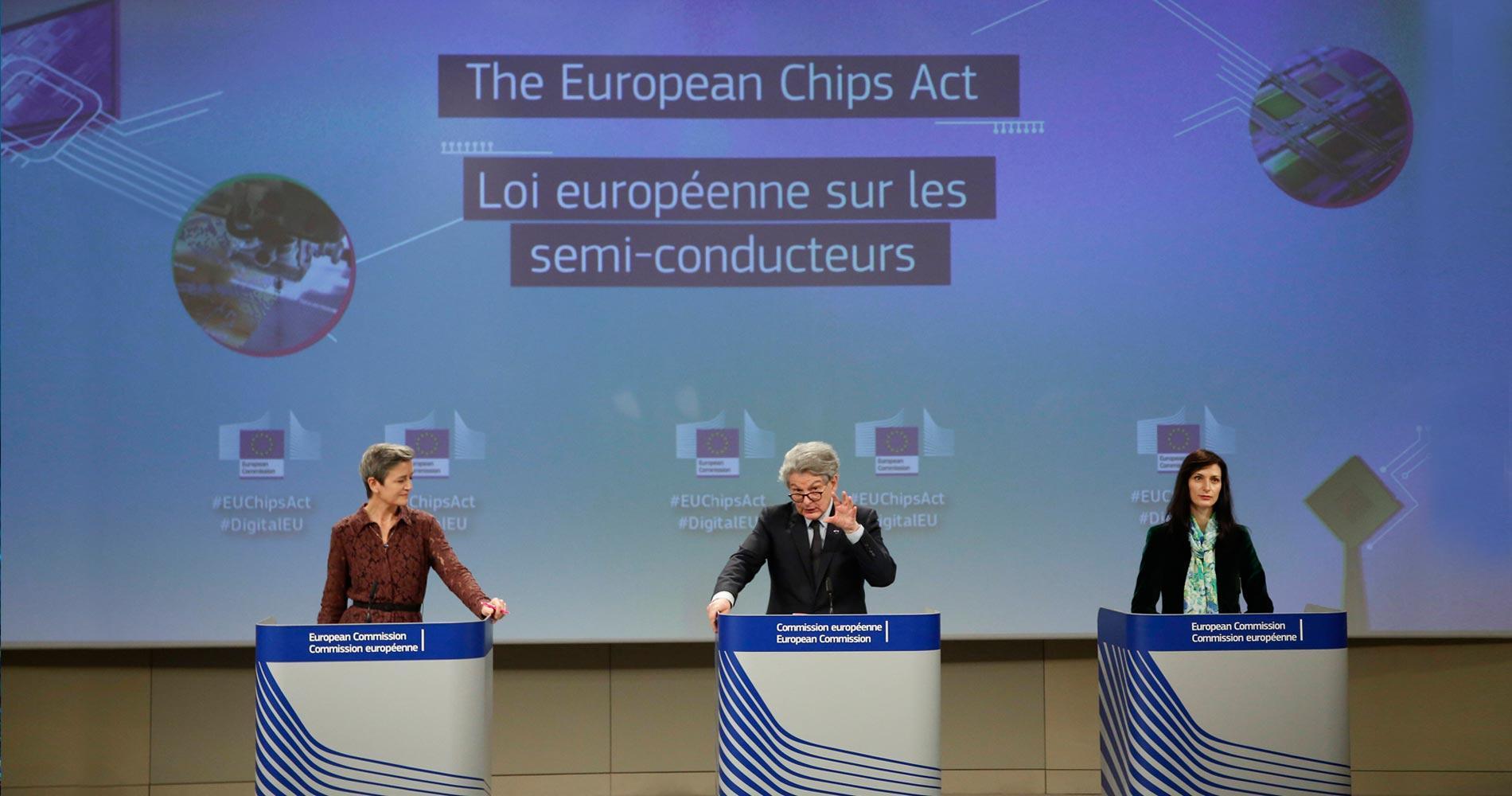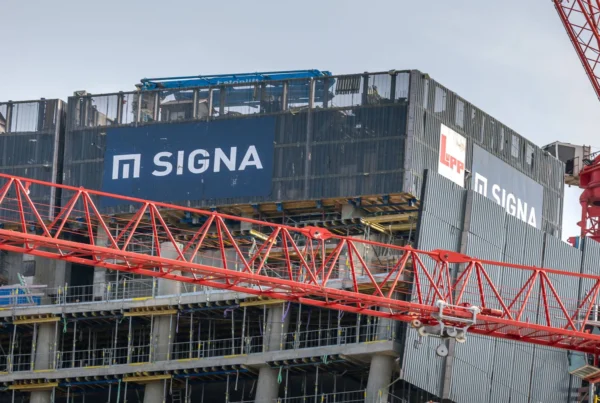The EU is set to pass the EU Chips Act in February 2023 which will aim to increase EU market-share in the industry to 30%. This ambitious goal is backed by public and private investment of more than € 43 billion to provide all the necessary tools for the industry. More than two-thirds of this money is designated for building new, leading-edge chip-fabrication plants, or “mega fabs.”
Sandy Chou, 8 February 2023
The establishment of the EU semiconductor industry can be traced back to the early 1950’s. The industry relies on the collaboration of governments, academics and global partnerships. Government subsidies often play a role in pushing for this industry’s development as it concerns national security and geopolitical interests. Europe is now pushing ahead with the EU Chips Act which aims to bolster technological capacity and innovation in Europe, and the Chips Joint Undertaking aimed at increasing investments in the industry.
The EU has maintained a steady share of 10% of the microchip production in the global market for the past few decades. In 2013, the EU launched a major project aiming to double the share to 20% by 2020. Due to the lack of cutting-edge fabrication plants, the EU maintained its 10% market share focused mostly on the automobile sector. In 2022, the EU launched a new Chips Act; this time aiming for a market share of 30% by 2030. This ambitious goal is backed by public and private investment of more than € 43 billion to provide all the necessary tools for the industry. More than two-thirds of this money is designated for building new leading-edge chip-fabrication plants, or “mega fabs.”
New amendments to the EU Chips Act have focused on next-generation semiconductor and quantum chips, the creation of a network of competence centers to address the skills shortage, and measures to attract new talent in the research, design and production areas. The EU aims to support projects which boost the supply of chips by attracting investment and increasing production capacity. This will also increase the EU’s security by bringing production back from China. The Chips Act is on the agenda for the EU parliament at the opening of the 13-16 February 2023 plenary session in Strasbourg.
The US’ CHIPS and Science Act has pushed ahead of Europe. On 6 December 2022, President Joe Biden visited Phoenix, Arizona for the opening of a new plant completed by the Taiwan Semiconductor Manufacturing Company (TSMC). TSMC’s investment, announced in 2020 during Donald Trump’s presidency, has exceeded 40 billion dollars, making it one of the largest foreign direct investments in the history of the United States. The company plans to produce advanced, smaller, 3-nanometer chips by 2026 at this new factory.
This move by TSMC is significant for both EU and the U.S. The EU has stressed the importance of international cooperation partners in the US, Japan, South Korea and Taiwan. The Commission is calling for the establishment of a chips diplomacy initiative which would address future disruptions to supply chain. “We want the EU Chips Act to establish Europe as an important player in the global semiconductors arena … Our goal is to ensure growth in Europe, prepare for future challenges and have in place the right mechanisms for future crises”. (Rapporteur on the Chips Act, Dan Nica).
TSMC manufactures 92% of the most advanced chips worldwide. The “foundry model,” in which TSMC works with “fabless” companies to produce semiconductor chips, has been TSMC’s primary model since the 1980’s. This model has proved to be the key to successful advanced chip-making for the past decade. The foundry model has produced more cutting-edge chips than the integrated device manufacturers (IDMs).
Intel, the leading IDM, is planning on building two German fabs, but Intel’s plan might falter due to geopolitical challenges, high inflation and energy costs. According to an Intel spokesman no definitive date for the start of construction has been set. Intel has consistently signaled that it would consider Europe only if governments shoulder at least 40% of the building costs. Intel’s ambiguous attitude largely depends on the amount of subsidy it will receive under the new EU Chips Act.
The European Union has expressed interest in other foundries building new factories in Europe. Possible locations for these new plants include Germany, Italy and the Czech Republic. To ensure success, the location will have to gather a significant amount of integrated circuit (IC) manufacturing companies, to create a steady supply for production equipment and material. Locations that have an established supply chain for foundries such as GlobalFoundries in Düsseldorf will be an attractive region because of the cluster effect in the IC industry. Dresden, a center for microchip production during the Cold War, is also being considered. Canada is another example of a country that has turned towards IC design rather than aiming for mass chip manufacturing.
Any location must also have enough qualified human capital. In order to help eastern European countries increase expert knowhow in semiconductors, five Taiwanese universities in Taiwan and TSMC have offered financial supports for college graduates from the Czech Republic, Poland, Slovakia, and Lithuania to study and intern in the industry based in Taiwan. Even if semiconductor foundries do not end up being built in these countries due to the high barriers to entry, countries with a long tradition of precision industry such as Austria, Germany and the Czech Republic could build plants for maintaining or assembling IC production equipment, and for providing the chemical air and liquid used for IC production.
The semiconductor industry is energy intensive. Foundries run non-stop, twenty-four hours a day. The high startup and running costs are currently being negatively impacted by Europe’s rising energy cost. Supplies of electricity and natural gas have to be sufficient and constant. While the majority of water can be recycled, an adequate supply of clean water is another important component. Purified water is used to wash wafers, which are a thin slice of semiconductor, as well as cleanroom gowns, and for testing and packaging. Pollution and exhaust of chemical materials can be reduced by changing the fabrication process, but the ever-evolving EU environmental and labor regulations continue to pose an obstacle for the semiconductor industry.
A less energy-intensive, more substantiable option for the EU is the production of matured process chips. Bosch and Infineon, among the most important suppliers of automotive semiconductors, are each constructing a new 300mm fab plant in Europe. The geometries of matured process chips are much larger than the current state of the art chip, but its manufacturing process offers a greener transition for the EU to rebuild its chip industry. Infineon Technologies Austria AG, located in Villach in Austria’s southern state of Carinthia, produces semiconductor chips and is a hub of R&D for semiconductor technologies.
The new EU Chips Act will do an excellent job in increasing EU subsidies and reinforcing the European electronics design ecosystem. While Germany, the Czech Republic and Italy are set to open new foundries, the regulatory and financial parameters of the new EU Chips Act, and the Chips for Europe Initiative, will be decisive in making this a reality. “Microchips are integral to the EU’s digital and green transitions as well as our geopolitical agenda. We are calling for fresh funding that reflects the strategic importance of Europe’s Chips sector. Europe’s partners and competitors are also investing heavily in their semiconductor facilities, skills and innovation.” (Rapporteur on the Chips Joint Undertaking Eva Maydell).
Picture: European Executive Vice-President Margrethe VESTAGER, left, European Commissioner in charge of Internal Market Thierry BRETON, center, and European Commissioner for Innovation, Research, Culture, Education and Youth Mariya GABRIEL, right speak at a press conference on the European Chips Act at the EU Commission headquarters in Brussels, Belgium, 8 February 2022. The European Commission proposed a 48 billion US dollar plan to confront semiconductor shortages and strengthen Europe’s technological leadership. Brussels Belgium. © IMAGO / ZUMA Wire
More Articles on the EU Chips Act:
Europe’s Future Role in the Global Semiconductor Industry







